
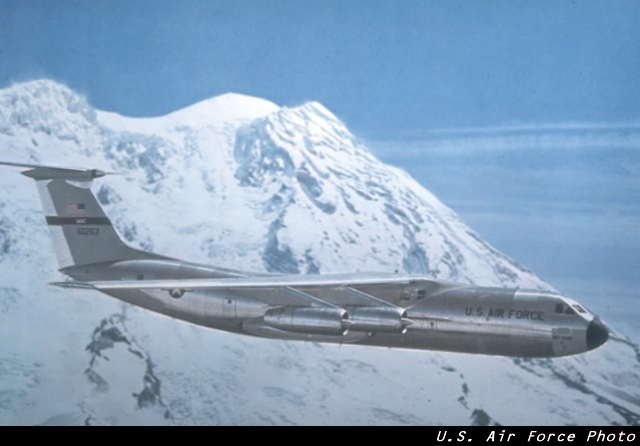
Early photo of 253 flying past Mt Rainier in Wa State, near McChord
Copyright © - USAF
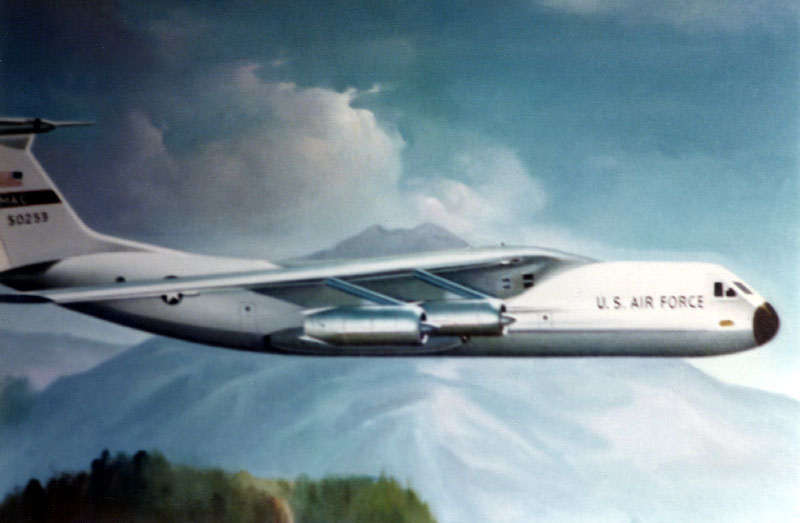
Bill Weeper submitted a snapshot of a painting of 253 that was done in the
Philippines.
It looks like it might have been modeled on the photo above, but it was artist's
license to substitute the local "Mt Rainier" in the background.
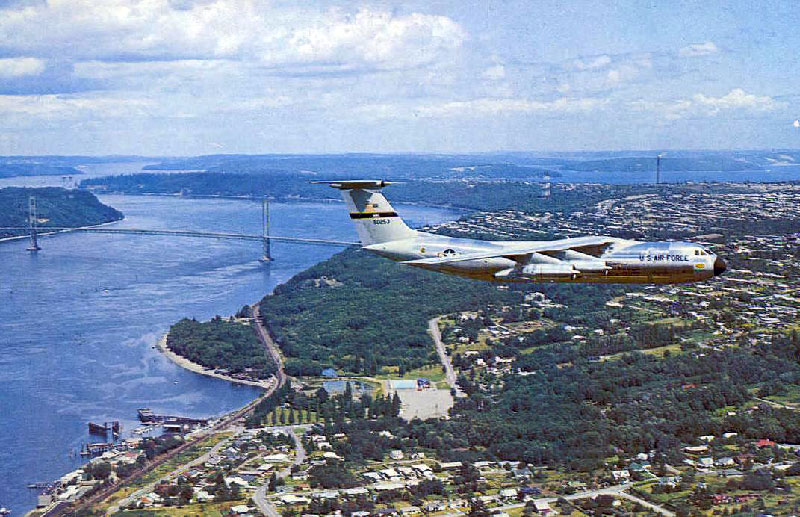
Flying past the Narrows Bridge in Tacoma WA in 1967
Copyright © - USAF
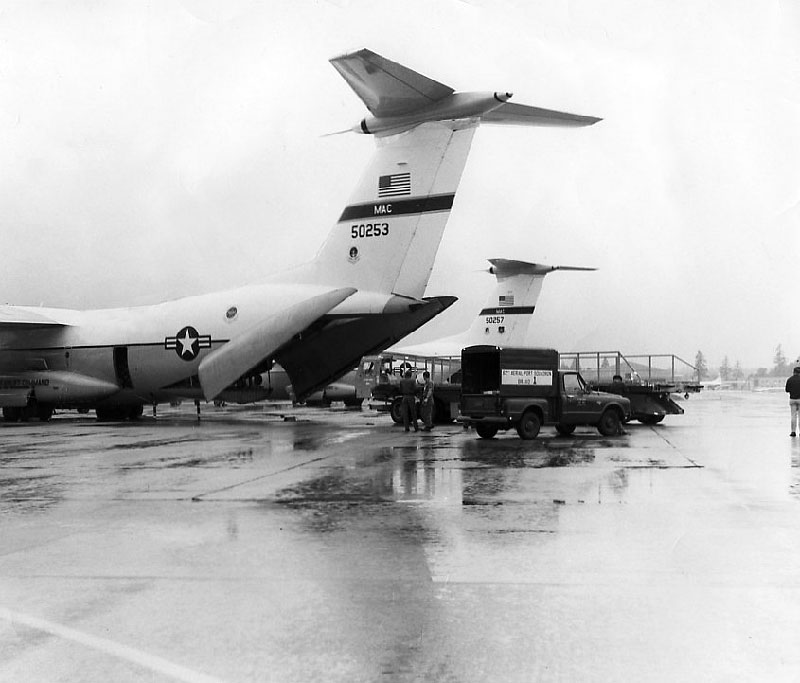
At McChord.
The truck says 62nd APS... and another clue: It's wet!
Source: USAF photo
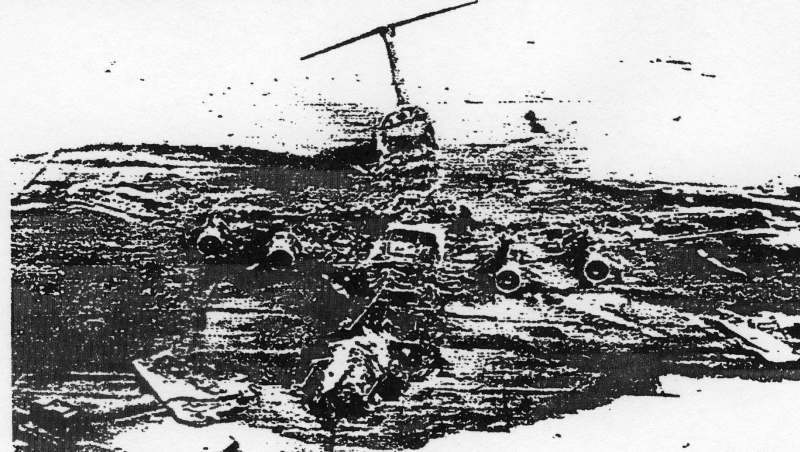

A bad day for 65-0253: It was destroyed on 7 October 1993 at Travis AFB, CA when
during fuel tank maintenance, the maintenance crew used 'non-standard'
procedures. The right wing exploded, and the aircraft was totally destroyed by
fire.
Source: USAF photo
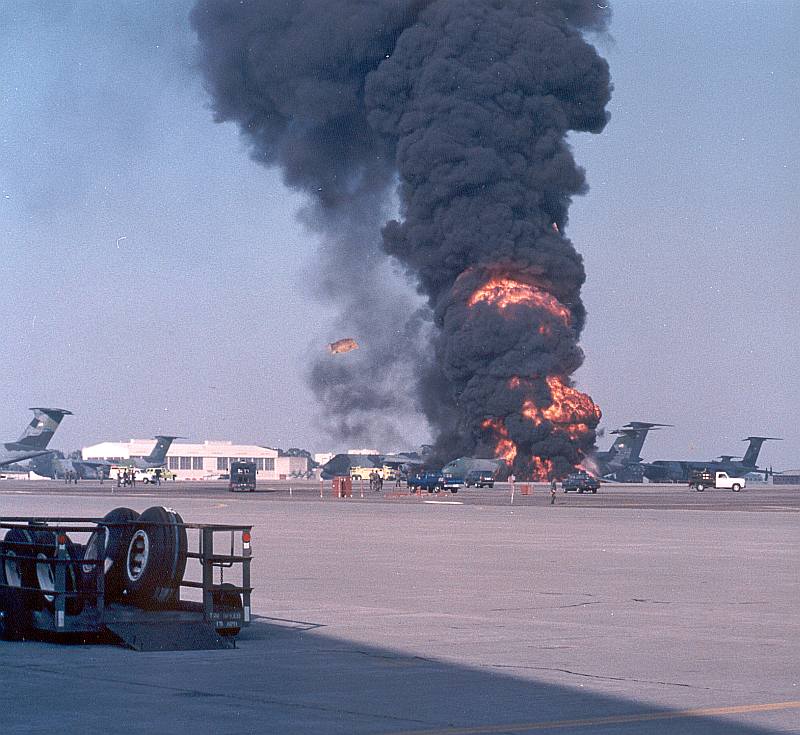
This photo, taken just after the initial fire started was submitted by Phil Webb (86MAS/708AS
.. Travis).
Note the life-raft on an explosion-induced flight of fancy.
Source: USAF photo
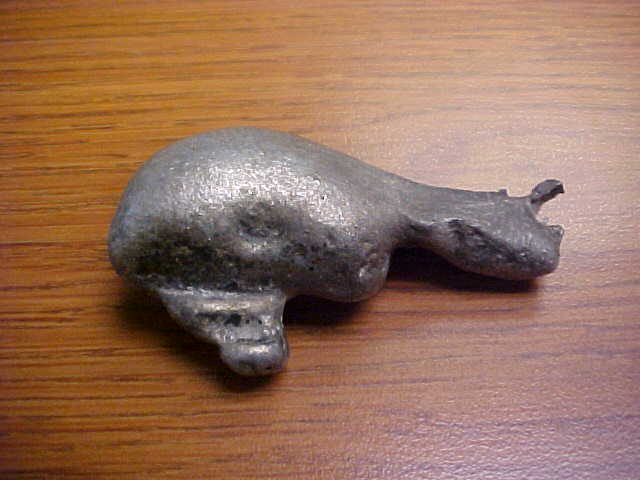
This photo was submitted by David Giancaspro. He commented:
"This little blob of aluminum is from the left wing area of 65-0253. It sat on
the ramp for several months during the investigation. After it was done we were
tasked to literally shovel it into dumpsters while a forklift removed the big
pieces (engines, tail, and nose section) Landing gear and the pet rocks were
pried off the ground also and hauled away. I keep that little souvenir on my
desk."
Copyright © - TSgt David Giancaspro USAF
On September 11th, 2009 we got this note from Joshua Potts, a fuel system
specialist currently based at Luke AFB, AZ:
I'm an active-duty Fuel Systems Repair Production Supervisor, and I was on-scene
when this incident occurred in 1993.
I was brand-new to the Air Force (Entered Jan 1993, and arrived at Travis AFB in
May, 1993) when this happened. Witnessing this aircraft explode, then burn away
to nothing was pretty much my intro to the AF. I will never forget it, and have
carried a very high level of detail since.
The writeup was "#4 Aux Boost Pump Inop." There are 2 boost pumps in each of the
C-141's fuel tanks…a Primary (outboard…due to the natural settling
of the fuel in negative dihedral wing design), and a secondary (Inboard). There
are quite a few discrepancies leading up to the actual explosion, but it started
off with pure complacency.
For starters…at the time, there were C-5's and 141's assigned at
Travis…two, very similarly designed aircraft. A civilian Fuel Systems
employee (who worked both types of aircraft on a daily basis) accurately
confirmed pump failure using the separation valves / pressure gauges / pressure
lights on the FMP, but he FAILED to document the correct pump nomenclature, a
mistake which later confused its location (He wrote up the "Outboard
Pump"…and had he been in a C-5, he'd have nailed it). Why? Because the
C-5's pump switches physically mirror their respective pumps' locations. If the
pump is physically outboard, so is its switch, regardless of left / right wing
location. This is NOT true on the C-141…if you look at the
panel…all switches (for either / both / left / right wings) are
labeled…from left to right…"Pri, Sec…Pri, Sec….etc.
He was not paying attention.
So..there was a documentation error. This led the crew from the oncoming
(Swingshift) shift to remove / replace the incorrect (Primary) pump, when
actually…the Inboard (secondary) pump was bad.
Enough fuel was transferred into the tank to submerge the Primary boost pump for
the Ops Check. Standard procedure. When they tried to perform the Ops
check…it did not come on. An electrician was called out to
troubleshoot…and he started with the relays. He requested (shouting from
the lav) a Fuel Systems person to reset the C/B at the FE's panel. Apparently
this was repeated a few times…and BOOM! The aircraft shook with a very
large concussion, and caught fire. Everyone egressed safely.
The AF was in the process of transitioning between JP-4 and JP-8 fuel at the
time, but A/C 253 was serviced with JP-4. I watched as it burned, and adjacent
tanks ruptured…from right to left…sounding very much like artillery
fire. I was amazed at the heat produced even from a safe distance.
After the investigation, the following facts were uncovered:
-Forms were not documented (the pump was still written up as "bad" with no
corrective action taken.
-The boost-pump scroll housing (an aluminum casting the pump plugs into) was
defective. There was too much porosity around the pump's cannon-plug area,
permitting intrusion of condensation. There was evidence (bluing) of prolonged
electrical arcing. This also led to the filling of the boost-pump conduit with
fuel / vapors.
-During ops check, the bad pump was not submerged…had it been, there would
not have been enough oxygen to feed an explosion / combustion.
We were instructed to perform One Time Inspections of all boost-pump scroll
housings…but it made no sense to me. You could not have seen this
particular defect without complete disassembly of each scroll housing (we were
not instructed to do this). There were defueling restrictions imposed on the
ground, during maintenance & servicing…which again…made no sense to
me. In flight, the inboard pumps were still permitted to run until dry. And to
REALLY add to the confusion…C-5's were placed on similar defuel
restrictions (which are inerted with nitrogen)…and they were left on this
restriction WELL beyond the time C-141's restrictions were lifted. Go figure.
Nothing was left but the tail, a bit of cockpit, and 4 lumps where the engines
had fallen.
Things you never forget.
I miss seeing those suckers in the air…I have a lot of scars on my
knuckles from those smelly old thingsJ
Joshua Potts, TSgt, USAF Luke AFB AZ
A little bit later I got a note from another person who was involved with the
incident...
First, I'm really glad to see that someone has devoted time and resources to keep
such a detailed account of my first aircraft's history. Your site wasn't hard to
find since it's the only one on the planet...go figure. As you might have guessed
from the e-mail's title, my greetings also come with a twist. You see, I read the
story from TSgt Joshua Potts and I must submit that his depiction of the actions
that caused the explosion are not entirely factual. No disrespect intended here,
Joshua graciously shared his thoughts and his emotions about the situation and
they are indisputable. So I thank you, Joshua.
How do I know this? I was the Airman First-Class 3-level Electrician on Swing
Shift who was called out with my 9-level Supervisor to troubleshoot that fuel
discrepancy that fateful October day. You see, this was my very first opportunity
to troubleshoot an on-aircraft fuels write up. I learned the system at FTD and
spent months learning the system from the tech data's GS, as was the case with
all my systems by order of my trainer. Since this was a system that rarely
failed, I was excited when my Section Chief and trainer, we'll call him EC,
pulled me out of roll call to work the "Red Ball".
Here's how the scenario went down:
EC and I arrived at the aircraft, immediately noticing the large number of
personnel within the "Circle of Safety". Day shift and swing shift fuels shop
personnel, day shift and swing shift flight line maintenance, and the flight crew
conducting their "-1" inspection, which totaled 30+ people creates a lot of
focused chaos. When we walked up to the flight deck we saw a technician at the
fuels management panel flipping the #4 Auxiliary Tank' s Secondary Boost Pump
Switch while an Airman was laying on the bottom bunk with his ear to the side of
the circuit breaker panel saying "it sounds like it's coming from in here". We
asked what they were doing, one of them said "we're trying to find the relays". I
asked my boss "shouldn't we be the ones troubleshooting the relays?" and he
agreed and asked them to stop. After a few minutes of "banter" about whose job it
was to troubleshoot the relays, EC and I began to evaluate the problem.
The first thing we did was to review the Fault Isolation Manual (FIM) for a
discrepancy code that matched our problem. We opened the TO on the "Pet Rock" at
pallet position #1, but did not find a matching discrepancy, so we began to
follow the closest fit in FIM's troubleshooting guide and used the wiring
schematics to work our way through the system. The first thing we noted was that
this was a system that required an "energized" circuit, or "power on" to
troubleshoot. So, we told the Fuels technicians and the Crew Chief that we were
working on a " live" system and not to mess with any of our switches unless we
requested assistance. We were conveniently located near the Avionics' Bays, where
the majority of the electrical control components were located (contrary to the
attempt by the fuels guys in the flight deck). I went upstairs and turned on the
#4 Auxiliary Tank's Secondary Boost Pump Switch to energize the system. After
checking and finding the right 3-phase power at the Control Relay, we were ready
for the second step.
The second step however, called for us to check power at a terminal board where
the wires split and go out to the wing. This was the halfway point of the
system's wiring that went to the pump itself. As you and every aircraft
maintainer already know, this is typical of FIMs in general, break the system in
half and cut down on the amount of wire chasing. The aircraft's terminal boards
are rarely defective (no moving parts and protected behind a hard-plastic cover
and the fabric cover lining the cargo bay), and more importantly, they were
located at the wing root of the aircraft. This was a crucial observation since
the aircraft was laden with "Pet Rocks", making the trip down the catwalk more
difficult. Since the FIM's tree was being used as a guide and we were following
the schematic, we opted to stay at the front of the aircraft to check the second
set of relays. A decision that likely saved our lives.
I'm not sure exactly what the power reading was at that second relay, because I
never made it that far. I know there was power there, because it was in that
instant that the explosion took place and knocked me and EC off our feet and
thrown into the corner where the latrine door hinged.
The first of the three reasons this mishap occurred, the part no one has ever
talked about and arguably the most significant, made the explosion possible.
Here's the deal…EC and I were set up for failure. Unbeknownst to us, the
fuels technicians were transferring fuel out of the #4 Aux Tank with the Primary
Pump in preparation to change the Secondary Pump we were troubleshooting. The
combination of the some basic facts led to disaster:
Power was being sent to the Secondary Pump for troubleshooting. The investigation
determined that the scroll housing (the pumps giant cannon plug) was internally
shorted between A and C phase power. This would not have been a problem, except
that fuel was being removed from the tank with the primary pump. Once the fuel
level dropped below the pump, the right parameters for an explosion now
existed...a source for ignition, residual fuel, and now air in the form of fuel
vapors.
If EC and I were allowed to finish the job we started, I'm confident we would
have found the problem. The events that occurred after the explosion…are
mostly irrelevant. Just know that jumping from a burning aircraft will etch the
unmistakable sight of soot-black smoke from an aircraft on fire into your memory,
show you how high a Liquid Oxygen (LOX) Cart flies into the air when it explodes,
and test all your Air Force emergency training. All this is happening while
thinking someone was trapped in the aircraft, and that's enough to make the
little hair on the back of your neck stand at attention every time you sense a
disaster in the making.
Here are a few more fun factoids that add to the details of this event:
The original discrepancy happened on the sortie the night of 6 Oct 1993, so
this was a "repeat" boost pump discrepancy.
My friend and neighbor was the Flight Engineer that wrote up the fuel problem
on the 6 Oct sortie that this first happened on, which we later discussed over
beverages in our apartment's hot tub, about how he felt "lucky" that it didn't
fail in flight.
The aircraft was fueled with JP-4 for my buddies flight, a simulated
heavyweight loaded aerial refuel sortie called a "Heavy A/R". These sorties have
large concrete pallets called "Pet Rocks" loaded in all but the ramp's pallet
position, and 253's configuration was no different.
Just as Joshua stated, the fuels technician mistakenly swapped the pump's
positions and the wrong pump was changed following the first flight. So, the
"bad" pump was never changed. His lack of attention to detail and complacency was
the second reason this mishap occurred.
Flight line electricians were not called to troubleshoot the first discrepancy.
The aircraft was recovering from a late morning sortie and was due to take off
later that evening for a "Night Heavy A/R" training sortie.
The aircraft was refueled for the first time with JP-8 on 7 Oct, not with JP-4
like depicted in Joshua's story, and was the only reason we survived this
incident. In fact, the second fuel truck had just arrived at the aircraft when EC
and I arrived. JP-8 has a much higher flash point and slower burn rate that JP-4.
This fact is what kept the fuel tanks from a rapid chain-reaction explosion and
the reason everyone walked away with their lives.
One Senior Airman quit smoking as a result of this mishap…he flicked his
Bick lighter just as the first explosion occurred. Sadly, he suffered hearing
loss as well and was not in the AF for much longer.
The right Tech Data was in use and turned to the right page, evidenced by the
charred TOs collected by the investigation team. I was asked if "that" was my TO
during questioning.
I still have my memory jogger from this incident. The Ace of Spades from my
deck of cards and a disfigured remote control to my Nissan truck that melted in
my backpack that was at the base of the crew entrance ladder. Both live in a
Ziploc bag in a safe place. I wanted the binder from the TO, but my request was
denied by the SIB President.
If someone, like the Crew Chief that was in the flight deck, had maintained
control over the situation on his aircraft, we could have kept that aircraft
alive. This lack of situational awareness, a key tenant of Maintenance Resource
Management (MRM), was the last of the three reasons this mishap occurred. Lastly,
I was asked to give an MRM briefing to my Maintenance Group next week on 4 Jan
2010, a "Safety Down- Day". I figured I would tell my story and was just looking
for a picture from a newspaper article when I tripped on your web site. I attest
that this is a valid first-hand perspective of what was a tragic day for many. I
can assure you the incident has paid off for this former Airman, who is now a
Maintenance Operations Officer for an Aircraft Maintenance Squadron.
Experience is the only thing you can't teach, so please feel free to share my
story. If it sheds some light on what could happen if you don't pay attention,
and prevents even one mishap, then our time was well spent. Again, I thank you
for your time and I look forward to reading some responses to this new
perspective.
Respectfully,
Mark
Capt, USAF
Maintenance Operations Officer